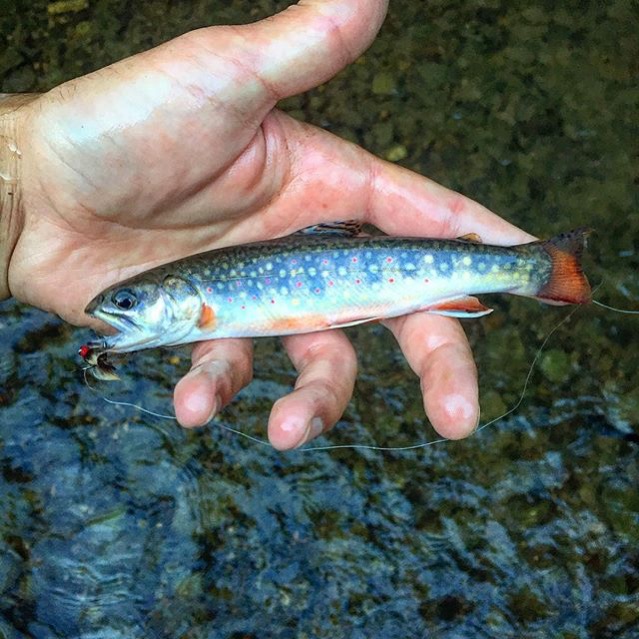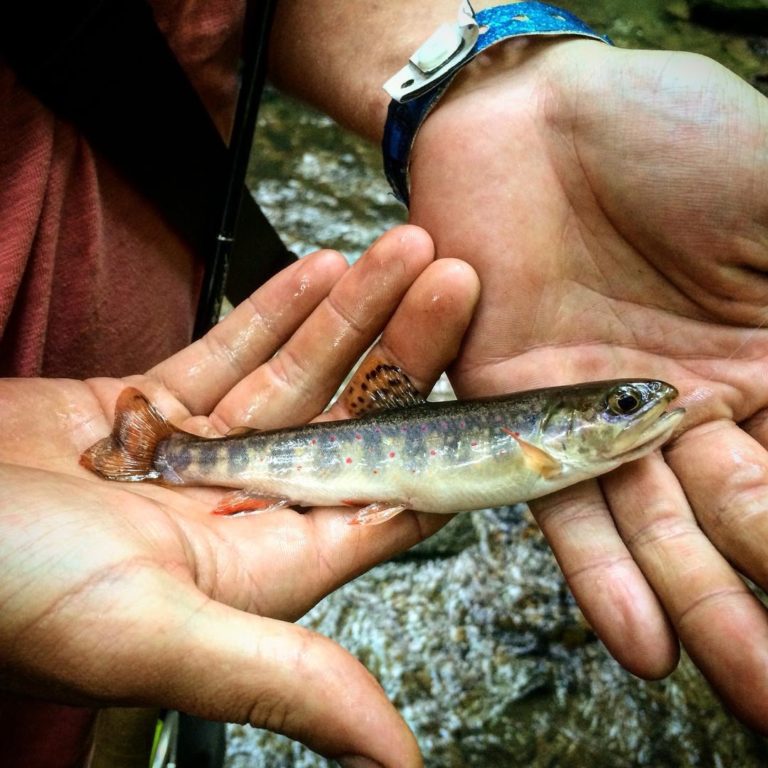The Brook Trout

The brook trout (salvelinus fontinalis) is a cold-water sport fish found in some areas of western New York. Brook trout typically range between 6 and 9 inches in length and can be identified by their gray-blue to sometimes olive-colored back and body, red bellies, and red pectoral, caudal, and anal fins that are tinged with white on their leading edge. Brook trout are typically smaller than rainbow and brown trout in western New York.
The brook trout is actually a char, not a trout. Brook trout are therefore more closely related to the lake trout, which is also a char. Interestingly, brook trout and lake trout are the only species of “trout” native to New York State, and the brook trout is our official state fish. Brook trout were once found in all counties of western New York. However, industrialization has decimated fish populations, especially in Erie, Niagara, Orleans, and Genesee counties where wild brook trout populations have largely been eliminated. There is a nice map of brook trout populations across the northeast on Maryland’s DNR website: http://dnr.maryland.gov/fisheries/Pages/brook-trout/index.aspx
Habitat
Brook trout prefer the cold, clean, well-oxygenated water of streams and creeks, especially those that are spring fed. Lakes and ponds that are fed from cold springs are also able to support brook trout. Because brook trout are a cold-water fish species, they generally cannot survive year-round in creeks or lakes that become hotter than about 65 degrees in the summer.
In streams and creeks, brook trout are typically found in deep pools, especially those with tree cover. During low-light periods, brook trout will sometimes venture into shallower parts of the stream or runs to feed.
The size of a stream or creek governs the size of the resident brook trout. Small streams will generally support smaller trout because of a smaller forage base. In many of the streams here in western New York, brook trout only average about 7 or 8 inches. Larger streams will generally contain larger fish, but brook trout larger than 12 inches are rare in western New York (at least to my knowledge).
Food
Brook trout generally feed on insects, with larger trout feeding on smaller fish as well if they are available in the stream or lake. In creeks and streams, brook trout commonly feed on nymphs, which are the larvae of aquatic insects. Brook trout will also feed on insects that fall into the water. On summer evenings or in the early morning, one can often witness brook trout sipping insects off the surface of the water.
Where to Catch Brook Trout
Wild brook trout, those born from natural reproduction and not stocked from a fish hatchery, are found primarily in the cold, spring-fed streams of Wyoming, Chautauqua, Cattaraugus, and Allegany Counties. There is a nice list of wild trout streams on the New York State DEC website: http://www.dec.ny.gov/outdoor/29286.html
Some waters in western New York receive an annual stocking of trout from a fish hatchery to augment naturally reproducing populations, while other waters cannot support naturally reproducing populations and rely solely on stocking to supply fish for anglers. Brook trout are stocked primarily in Wyoming, Cattaraugus, Chautauqua, and Allegany Counties. There is a list of all bodies of water stocked with trout annually on the New York State DEC website: http://www.dec.ny.gov/outdoor/30465.html
Among rainbow, brown, and brook trout, brook trout are the hardest to come by here is western New York. One will usually have to venture a ways out into the countryside to find any population of brook trout. The Wiscoy Creek system and Allegany State Park are two popular places to target brook trout. Pictured below is a brook trout caught at Allegany State Park.

How to Catch Brook Trout
Fly-fishing is one popular method for targeting brook trout in creeks and streams. Productive baits for brook trout on the fly include black or brown nymphs, size 14-20, fished under an indicator. Split-shot weight should be added depending on how fast the water is moving and whether or not the nymph is weighted with a bead-head. In the early morning or evening hours, dry flies such as caddis patterns, tricos, or mayflies can be used to catch fish sipping bugs off the surface.
For the spin fisherman, small Mepps® spinners are productive lures. Fishing worms on a small hook with some split shot is also good strategy. When fishing lakes or ponds, spin fishing is probably the best way to go. Brook trout can be caught on worms or Berkley Powerbait® fished off the bottom or under a bobber.
Spring and fall are the best times to target brook trout, when the weather is cool and creeks and streams have decent flows. Fishing in the dog days of summer, when creeks are warm and low, is extremely challenging and can put extra stain on fish, which is detrimental to their health.
